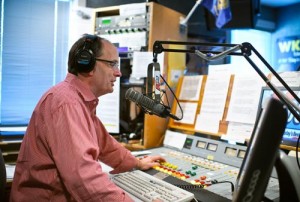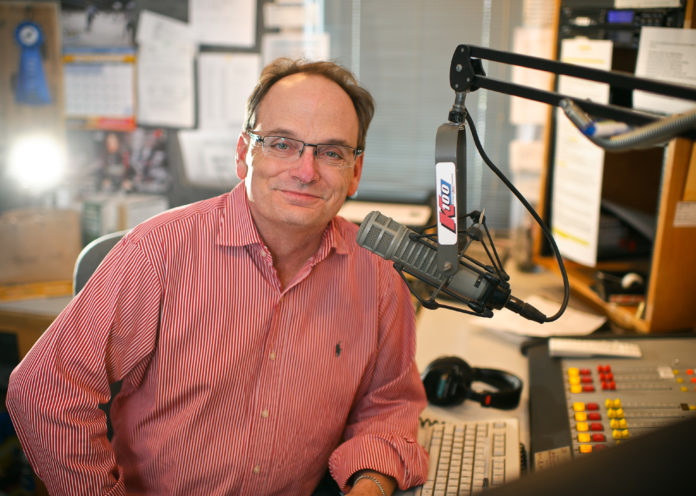Ken Dumminger described being on the National Transplant Waiting List as “absolute sheer panic.”
His daughter asked if he was going to die.
He fought the misconception that his renal failure was linked to alcoholism.
He worried about how he was going to pay for the liver transplant — if he was lucky enough to get one.
And then the phone rang.

Radio host Harvey Steele, who is celebrating 15 years as a liver recipient, now promotes organ donation. Toledo Free Press Photo by Joseph Herr.
It was local radio personality Harvey Steele.
“I got a call one day from Harvey and he said, ‘A little birdie told me you are on the transplant list,’” Dumminger said.
“I personally think he got my name from the transplant center in the Cleveland Clinic,” Dumminger said. “He will deny it or won’t say anything about it, but that is how he works. Harvey is a little bit of an evasive individual; he doesn’t tell you everything he knows.”
But Dumminger didn’t care. The Fremont resident welcomed the conversation with Steele, who has thrived since his 1997 liver transplant.
“I had no idea what they were going to do and what was going to happen and that is when Harvey stepped up to the plate and said, ‘Ken, don’t worry about this. I have been through this. While it is a little bit terrifying, you will make it.’ He gave me the total concept that everything will be OK.”
And everything was OK. Dumminger had his transplant in January 2002, which his insurance helped cover (not everyone is as lucky), and Steele never lost touch.
“It wasn’t like he just contacted me once; he contacted me on a regular basis,” said Dumminger, now 65. “Basically, he set it up so he was my mentor.”
Even as Steele celebrates the 15th anniversary of his transplant, he continues to mentor those who are on the National Transplant Waiting List. He promotes organ donation — the gift of life — just as passionately.
“I still talk to people who are in my situation,” Steele said. “I say, ‘The surgery is the least of your issues. You have to deal with the fact that in order for you to live, someone else has to die.’ Not only that, but the family has to donate their organs; they have to be nice enough to do that.”
Steele remembers his mental state at the Cleveland Clinic.
“You are in a place you thought you would never be. I would go to the end of the hall and there would be guys looking out the window, looking for helicopters to come to the Cleveland Clinic — maybe they had something for them.
“They would watch the news to see if there were automobile accidents,” Steele said. “It wasn’t that you wanted something bad to happen to someone else; you just had no control.”
It was 1985, and Steele was just 28 years old. His second daughter, Allison, had just been born.
Like many new fathers, he wasn’t sleeping much.
“I had that permanent headache because I felt the need to be up half the time even though I couldn’t breastfeed. It was sort of that dull headache; I was popping a couple of aspirin every four hours and it gave me a bleeding ulcer.”
The bleeding ulcer took him to the hospital where he received eight units of blood — at least one contained what later became known as Hepatitis C. It was just six months before screening began for the virus.
The next time he donated blood, he got a letter. He made an appointment with his doctor.
“I was told, ‘You will have elevated liver enzymes, but that is about it,” Steele said.
In August 1997, his belly began to fill with abdominal fluid as his energy diminished. After going to his primary doctor and being misdiagnosed, it became clear his 40-year-old liver was in trouble.
“I was operating under the assumption that I didn’t have anything to worry about with the liver, but when I noticed my yellow tinge, I knew that would be jaundice and it is directly related to the liver one way or the other.”
Steele was diagnosed with end-state liver disease. After three days of tests, it was determined he was sick enough to need a transplant, but healthy enough to survive the surgery.
At that time, there were 60,000 people on the National Transplant Waiting List — waiting for organs like livers, hearts, lungs and kidneys. That number has grown to more than 116,000 today.
“It was good news, and bad news,” Steele said. “The good news: I made it on the National Transplant Waiting List; the bad news: I am on the National Transplant Waiting List.”
Steele continued to work his half of “Shores & Steele” (then an afternoon show on K100) as he waited the estimated 18 months before a liver would be available.
“I [would] come in during the morning, take a nap and then come back and work those three hours and then pretty much collapse,” Steele said. “I am thinking, ‘How am I supposed to do this for a year and half?’”
Meanwhile, he kept getting blood tests until his beeper went off in early September.
It was the transplant office at the Cleveland Clinic. The blood test results indicated he had become too sick to wait at home.
He had to wait at the clinic, even though the doctors had nothing for him.
He had to decide what to tell his listeners.
“We have always been in the community and always doing things,” Steele said. “It became rather obvious when Gary is on and I haven’t been on.”
Gary Shores remembers the time well. He saw Steele’s plight as a chance to rally listeners behind his radio partner, while simultaneously informing people about the desperate need for more donors.
“I have an intercom at my disposal and I need to play more than hits,” Shores said. “We had Harvey on the radio and he revealed that he was going to have a liver transplant.”
The listeners reacted. Life Connection, a nonprofit designated by the federal government as the Organ Procurement Organization for Northwest and West Central Ohio, received dozens of calls a day asking about Steele and how to become a donor. “Say a Prayer for Harvey” signs were hung throughout town.
People sent thousands of cards, all of which Steele read and still has to this day.
“The people in this community are simply amazing,” Shores said.
No one entertained the idea that his co-host might not make it.
“Everyone kept a positive thought,” Shores said. “We didn’t allow that thought. It would have been unacceptable.”
These days Steele jokes about how close he came to death.
“All the TV stations covered it,” Steele said. “I looked like hell. The people in Cleveland would say, ‘Are you sure you want to do this?’ All the TV stations were competing for the last footage of me.”
Steele continued to give interviews as he lived at the clinic. Halloween came and went. He actually started to resemble a pumpkin, he said.
“All they could do was manage my symptoms; there was no way to improve symptoms. When your liver doesn’t work, everything goes wrong. I had good days and bad days, which was more like good hours and bad hours.”
The hallucinations set in. His wife, Mary Beth, and two girls would visit on the weekends. He would have conversations with them, but wouldn’t remember any of it.
Then on Nov. 2, 1997, he was awakened by some nurses.
They had a match.
Hours later, he learned the new liver was in him, but it wasn’t functioning like it should. It wasn’t a rejection; it just wasn’t starting up like the doctors had hoped.
All hazy, he heard the surgeon say, ‘We are going to look for another liver.”
Steele thought the drugs were talking.
“I don’t ever have to play the lottery because I have won it twice,” he said. “Later that day, they found another liver. The odds of which are astronomical.”
He received his second — and current — liver Nov. 5.
Today, Steele’s daughter, Kara, has made it her life’s work to recruit donors.
Kara was just a teenager when Life Connection was receiving hundreds of calls about her father, she said. She is now director of community relations for Life Connection of Ohio.
“From a young age, going through that experience, I realized that in some way I wanted to find a way to give back for the gift that my dad received,” she said.
But there was a time when she didn’t know if she would get to see her dad live, let alone work with him on this cause.
“I blocked out a lot of that time. I don’t remember it. What I do remember is being really, really scared. I thought, ‘Is my dad going to live at the Cleveland Clinic or is my dad not going to live?’”
Thankfully, he lived because of the generosity of an organ donor, she said.
Misconceptions about organ donation are common. Some people are afraid if their license indicates they are a donor, the hospital staff won’t work as hard to save them.
Not true.
“That is why Life Connections exists separately,” Kara said. “Hospital staff is there to save lives. If that is not a possibility and that person passes then organ donation is an option.”
People also worry about open-casket funerals. They shouldn’t. If an open casket is possible before organ donation, it is possible afterward.
Additionally, organ donors can change their minds after registering through the Department of Motor Vehicles or www.DonateLifeOhio.org, Kara said. Potential donors could even just express their donation wishes to their families.
Her dad said donor families are heroes. He has exchanged letters with his donor family and learned his liver came from a 60-year-old high school electronics teacher who died of a brain aneurysm. He left behind a wife and three grown sons. This is humbling when Steele thinks of the 15th anniversary of his liver transplant.
“There is no cake or celebration. You feel very lucky to be alive. Any anniversary is also when someone out there lost a loved one,” Steele said. “It would be entirely inappropriate to shoot off a firework and go ‘woo hoo.’ I wouldn’t be here if it weren’t for those people who, in the worst possible time in their life, thought of someone else.”























